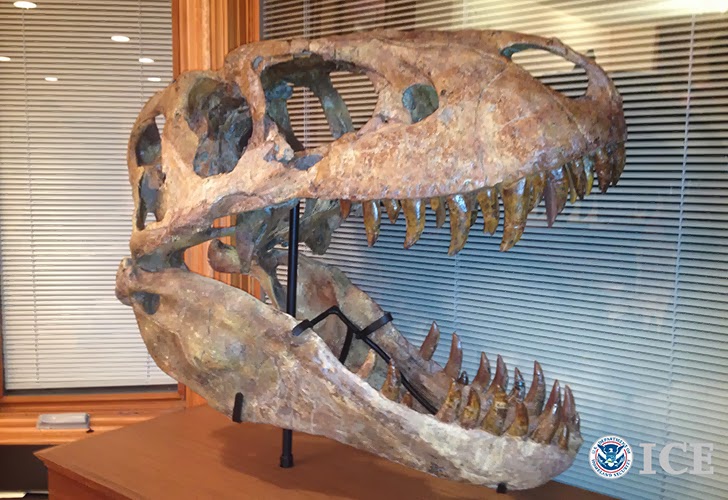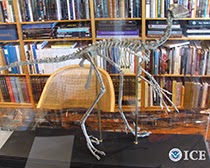 |
| One of the Tyrannosaurus Bataar skulls seized by ICE. |
After news broke of the forfeiture case of United States v. One Tyrannosaurus Bataar Skeleton, a Bataar skull of Mongolian origin and in the possession of fossil dealer John Richard “Rick” Rolater quickly disappeared from public view. That led to a tipster’s call and a subsequent federal investigation.
U.S. Immigration and Customs Enforcement (ICE) calls Rolater a “fossil retailer” who operates stores in Wyoming and Colorado. He pleaded guilty in Wyoming federal district court last week to a charge of conspiracy to commit smuggling under 18 U.S.C. §§ 371 and 545 for illegally dealing in dinosaur fossils.
ICE said in a prepared statement that the Bataar skull displayed in Rolater’s Jackson, Wyoming store vanished from sight around June 2012, the time when federal prosecutors filed an unrelated dinosaur forfeiture case in New York. ICE’s Homeland Security Investigations (HSI) soon afterwards executed a search warrant and located the skull secreted away, “hidden in a closet of the rented residence of the store’s director, which was owned by Rolater.” Two months later agents located a fossilized Gallimimus foot and a fossilized juvenile Bataar skull, “hidden in the crawl space of Rolater’s house,” according to authorities.
“These fossils had been illegally exported from China and Mongolia, and then illegally imported into the United States,” explained Kumar C. Kibble, special agent in charge of HSI Denver, which covers Wyoming.
Christopher “Kip” Crofts, the U.S. Attorney in Wyoming, last Thursday put his signature to a single information charging Rolater with unlawfully conspiring to smuggle Chinese vertebrate fossils into the U.S. between May 2010 and May 2012. The criminal complaint tells how the conspirators generated phony invoices in order to smuggle the goods past customs. The information recites,
Rolater received emails from his Chinese supplier describing how the supplier would package Chinese vertebrate fossils in a manner to subvert both Chinese and United States customs and import regulations.
In 2012, knowing that the Chinese supplier was willfully and intentionally subverting Chinese and United States import and Customs regulations, Rolater continued to communicate via email with the Chinese supplier to solicit Chinese vertebrate fossils from his supplier which Rolater intended to resell in the United States.
 |
| A seized dinosaur skeleton. |
Together the Chinese and Mongolian objects seized by ICE and selected for appraisal totaled $2,450,815. Among the items identified were three Bataar skulls worth $1,875,000, four Micro-Raptors priced at $173,000, a Protoceratops valued at $100,000, and a Gallimimus skeleton also valued at $100,000.
Rolater will pay a $25,000 fine, receive two years of probation, and return the fossil specimens in exchange for his plea of guilty.
UPDATE: More details about the case can be found in the government’s forfeiture pleading, described here.
Photo credits: ICE
This post is researched, written, and published on the blog Cultural Heritage Lawyer Rick St. Hilaire at culturalheritagelawyer.blogspot.com. Text copyrighted 2010-2014 by Ricardo A. St. Hilaire, Attorney & Counselor at Law, PLLC. Any unauthorized reproduction or retransmission of this post is prohibited. CONTACT INFORMATION: www.culturalheritagelawyer.com
©2010-2022 Cultural Heritage Lawyer Rick St. Hilaire. Content discussing cultural heritage law, art law, looted antiquities, stolen artifacts, and museum risk management that is general information only, not legal advice.



